
Choosing a willow
Discover the diversity of willows to suit all your desires.
Contents
The willows, found along the waterways of our regions, are among the oldest flowering trees. With nearly three hundred species, the range is vast, from small creeping willows to dwarf willows and weeping willows. All are young plants that are simple to grow, as they are resilient and vigorous, sometimes too much so. They will delight you throughout the seasons with their colours, as well as the variety of shapes of their leaves and flowers. The genus Salix offers an unexpected diversity. Let yourself be guided and become a willow addict like us!
We offer a selection of the most interesting willows based on soil criteria, size, colours, or uses, to help you refine your choice.
To avoid any failures, plant appropriately: download our web application Plantfit.
According to height
Creeping Willows from 0.60 m to 1.50 m High
The Salix repens and Salix repens ‘Nitida’ are well suited as groundcover due to their dense silvery foliage. The Salix helvetica is ideal for rockeries with its velvety almond green leaves and its undulating spreading habit, just like the Salix sibirica subopposita which forms a cushion with its velvety and silky catkins and young shoots. The Salix hastata ‘Wehrhahnii’ is very decorative with its red branches and long silvery catkins.
Dwarf Willows from 1.50 m to 3 m
Dwarf willows are ideal for small gardens, in rockeries, or even in pots on a balcony or terrace. The Salix (x) tetrapla with its upright yellow branches turning grey-brown, is covered with small oval bright green leaves on top and grey underneath. The Salix aurita is a large bush reaching 3 m in height that withstands salt spray well.
Medium-Sized Willows from 5 m to 10 m
They are appreciated for their natural appearance, planted in masses by water bodies. Opt for the Salix triandra or almond willow with reddish-brown or olive green branches, while the Salix cinerea with grey leaves is ideal for brightening a damp understorey. To use as a solitary specimen for its graphic silhouette, choose the Salix matsudana ‘Tortuosa’ with its twisting stems that undulate and create an exceptional silhouette in winter. It can reach up to 10 m in height. More decorative for its flowering, the Salix caprea, a small tree of 5 to 8 m, has numerous decorative silvery catkins with long yellow stamens. Note that its weeping version Salix caprea pendula ‘Kilmarnock’ is spectacular on a terrace.
Large Willows from 10 m and Beyond
The Salix alba with its silvery grey foliage can reach 25 m in height, although it is often treated as a pollarded tree. It is reserved for large gardens or large ponds. The variety ‘Vitellina’ has yellow wood. Its rounded habit is perfect for brightening dark spots. The Salix alba ‘Tristis’, the weeping willow, reaches 10 to 15 m in height and as wide with its flexible stems that droop to the ground.

From the Salix subopposita with its creeping stems at the top to the recognisable weeping willow at the bottom, willows of all sizes showcase diversity. In the centre Salix exigua and on the right Salix caprea; at the bottom Salix cinerea.
According to the colour of the aments and the barks
Celebrating the arrival of spring as early as February, willows offer delicate flowering in a variety of colours. White for Salix hastata ‘Wehrhahnii’, pink for Salix chaenomeloides ‘Mount Aso’, yellow from Salix aurita, and even black for Salix gracilistyla. Elegant and with a naturally simple style, yet the small details within the flowers add even more charm.
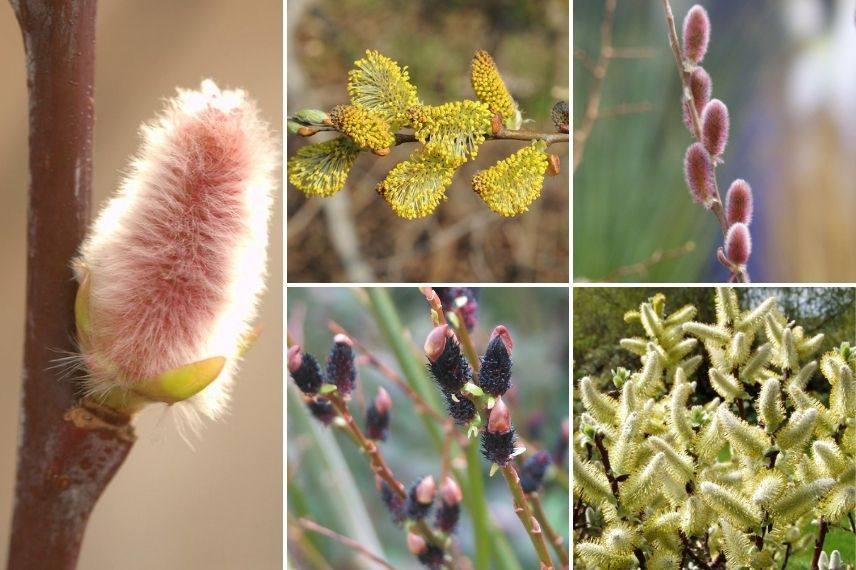
On the left, Salix acutifolia in a candy pink tone. In the centre, Salix aurita yellow and Salix gracilistyla almost black. On the right, Salix ‘Mount Aso’ and the bright white of Salix hastata ‘Wehrhahnii’
The barks, especially those of young shoots are part of the spectacle. They are orange-red in Salix erythroflexuosa and Salix alba ‘Vitellina’. Purplish-red in Salix sachalinensis ‘Sekka’, Salix magnifica, and Salix ‘Fargesi’. Another characteristic of willows is their variability in appearance throughout the seasons. This is true for Salix viminalis or basket willow, whose long, flexible, and downy shoots are green-grey then yellow-green to yellow-orange as they mature.
Discover other Willow - Salix
View all →Available in 1 sizes
Available in 1 sizes
Available in 1 sizes
Available in 1 sizes
Available in 1 sizes
Available in 1 sizes
Available in 1 sizes
Available in 1 sizes
Available in 2 sizes
Available in 2 sizes
According to the flowering period
Three highly decorative willows celebrate the end of winter with an explosion of colours.
- The Salix acutifolia ‘Blue Streak’ is a large hardy bush that awakens in February with long silky silver aments that turn yellow. Its young red branches take on a bluish violet hue.
- The Salix chaenomeloides ‘Mount Aso’ is a ramified shrub with beautiful pink and red aments. They form in autumn under red scales among the yellow-orange foliage. They develop in March on brown-pink branches, covered in a “fur” of red hairs at the base, pink at their tips.
- The Salix sachalinensis ‘Sekka’ has a early and abundant spring flowering and produces a multitude of large feathery aments, silver then yellow.
May sees the flowering of wilder willows such as Salix alba, Salix viminalis and Salix caprea. Summer sees the Salix lanata conclude the show with its large woolly white aments alongside its foliage.
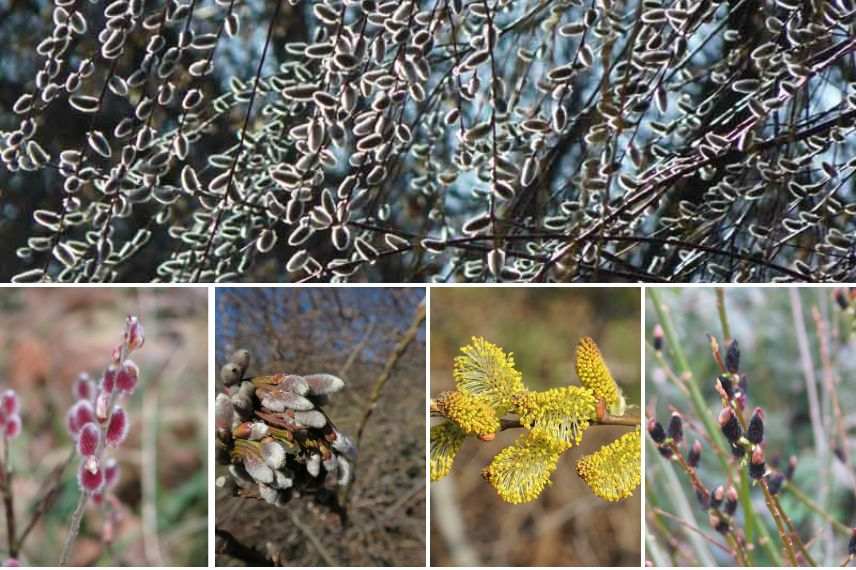
Explosion of aments at the end of winter in Salix acutifolia from left to right Salix chaenomeloides Mount Aso, Salix sachalinensis ‘Sekka’, Salix aurita, Salix gracilistyla
Read also
How to make a living willow hut?According to the pH and the nature of the soil
The name Salix comes from the Celtic “sal” meaning “near” and “lis” which means “water“. Thus, all willows share a common preference for cool, deep soils in which they plunge their powerful roots. Even though most willows thrive in ordinary ground like the wonderful shrimp willow Salix integra ‘Hakuro Nishiki’, some are adapted to more acidic or calcareous soils. If your soil is acidic and heavy, choose Salix repens nitida and Salix aurita. Reserve Salix argentea and Salix cinerea for cool, light acidic soils. For gardens with calcareous soil, opt for the Salix rosmarinifolia in a mass or hedge or the Salix helvetica in a rockery with poor, cool soil.
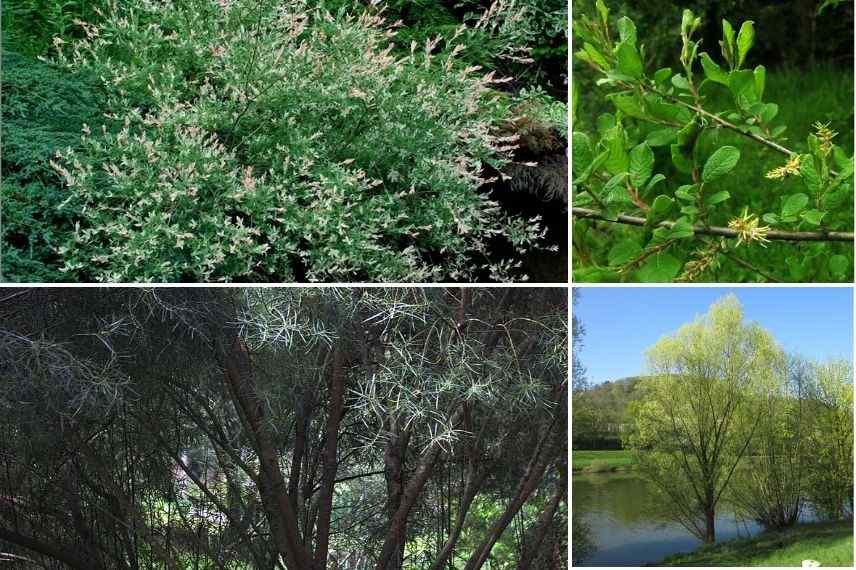
All willows need water like Salix alba at the bottom right. Above for heavy, acidic soils Salix aurita. Top left neutral ground for the small shrimp willow. Below poor, calcareous soil for the rosemary-leaved willow.
According to the habit and use
In nature, willows are everywhere. They thrive both on the coast and at the tops of the highest mountains. In the garden, the tallest willows are placed as solitary specimens or at the back of the garden, while shrubby willows are planted in clusters further forward. Willows require severe pruning each year to regain all their beautiful colours for the following season. The large willows will be pollarded (pollarded trees), while the shrubby ones will be cut back. To enhance a slope or a cool rockery, plant prostrate willows, which will hold the ground in place with their suckers.
To brighten up a terrace, it is possible to grow willow in a container. The twisted willow Salix matsudana ‘Tortuosa’ in a large container will resemble a large bonsai. The shrimp willow Salix integra ‘Hakuro Nishiki’ is ideal for brightening up a terrace. The weeping variety of goat willow Salix caprea ‘Kilmarnoch’ will also make a statement with its dome of aments.
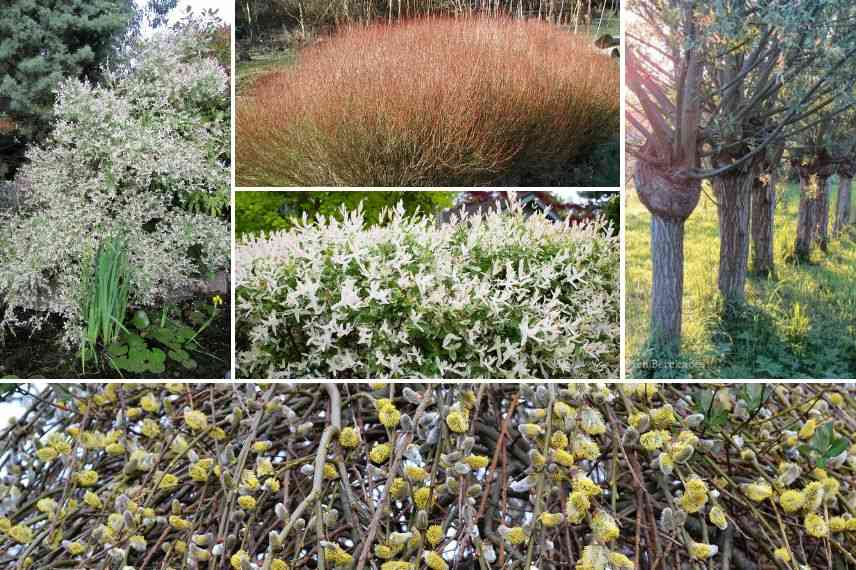
The Salix purpurea and its young cut back shoots at the top. To the right, a traditional pollarding on Salix alba. On the left, the shrimp willow Salix integra ‘Hakuro Nishiki’ as a solitary specimen and in a hedge. Below, the flowering dome of the weeping goat willow Salix caprea ‘Kilmarnoch’, which is suitable for pot cultivation on a balcony.
For further reading
Willow is used in agriculture to provide the osier that is used to make wickerwork items. Willow can also be woven once planted in the garden. Have fun discovering Alexandra’s tips to get started with weaving living willow and its practical use in the garden. Explore our collection of woven living willow in a domed shape or column.

Two examples of living woven willow hedges
- Subscribe!
- Contents
































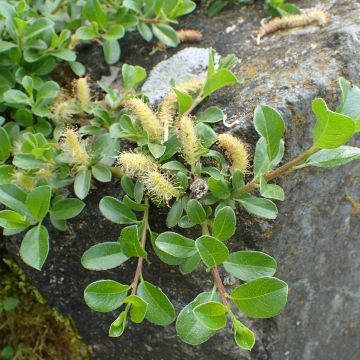
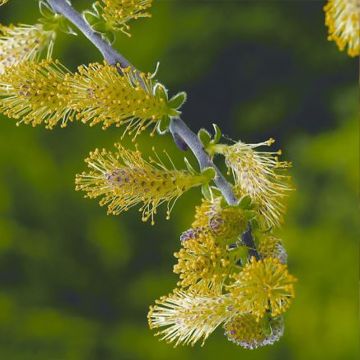
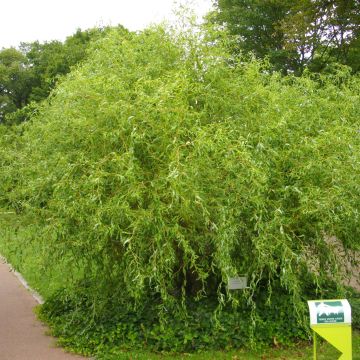


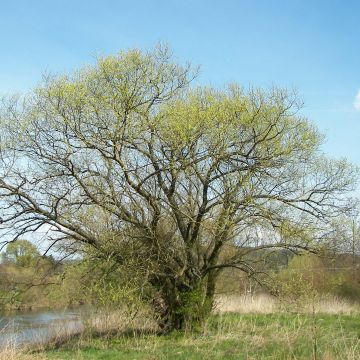

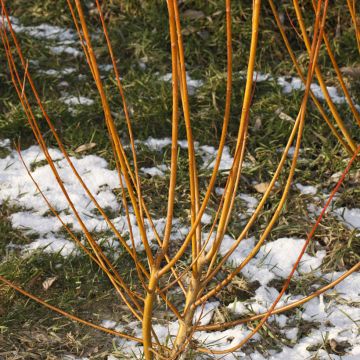

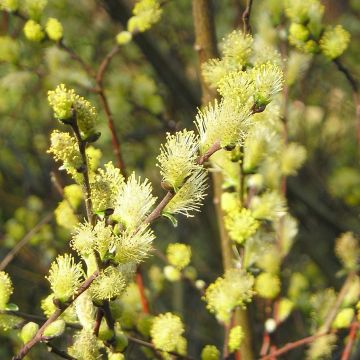
Comments